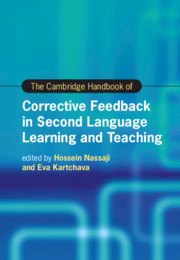Book contents
- The Cambridge Handbook of Corrective Feedback in Second Language Learning and Teaching
- Cambridge Handbooks in Language and Linguistics
- The Cambridge Handbook of Corrective Feedback in Second Language Learning and Teaching
- Copyright page
- Contents
- Figures
- Tables
- Contributors
- Acknowledgments
- Introduction Corrective Feedback in Second Language Teaching and Learning
- Part I Theoretical Perspectives on Corrective Feedback
- Part II Methodological Approaches in the Study of Corrective Feedback
- Part III Different Delivery Modes of Corrective Feedback
- Part IV Feedback Provider, Feedback Intensity, and Feedback Timing
- Part V Corrective Feedback and Language Skills
- Part VI Contexts of Corrective Feedback and Their Effects
- Part VII Learners’ and Teachers’ Feedback Perspectives, Perceptions, and Preferences
- 26 Teachers’ and Students’ Beliefs and Perspectives about Corrective Feedback
- 27 Written Corrective Feedback and Learners’ Objects, Beliefs, and Emotions
- 28 The Role of Training in Feedback Provision and Effectiveness
- 29 Perceptions and Noticing of Corrective Feedback
- Part VIII Individual Differences, Tasks, and Other Language- and Learner-Related Factors
- Index
- References
26 - Teachers’ and Students’ Beliefs and Perspectives about Corrective Feedback
from Part VII - Learners’ and Teachers’ Feedback Perspectives, Perceptions, and Preferences
Published online by Cambridge University Press: 26 February 2021
- The Cambridge Handbook of Corrective Feedback in Second Language Learning and Teaching
- Cambridge Handbooks in Language and Linguistics
- The Cambridge Handbook of Corrective Feedback in Second Language Learning and Teaching
- Copyright page
- Contents
- Figures
- Tables
- Contributors
- Acknowledgments
- Introduction Corrective Feedback in Second Language Teaching and Learning
- Part I Theoretical Perspectives on Corrective Feedback
- Part II Methodological Approaches in the Study of Corrective Feedback
- Part III Different Delivery Modes of Corrective Feedback
- Part IV Feedback Provider, Feedback Intensity, and Feedback Timing
- Part V Corrective Feedback and Language Skills
- Part VI Contexts of Corrective Feedback and Their Effects
- Part VII Learners’ and Teachers’ Feedback Perspectives, Perceptions, and Preferences
- 26 Teachers’ and Students’ Beliefs and Perspectives about Corrective Feedback
- 27 Written Corrective Feedback and Learners’ Objects, Beliefs, and Emotions
- 28 The Role of Training in Feedback Provision and Effectiveness
- 29 Perceptions and Noticing of Corrective Feedback
- Part VIII Individual Differences, Tasks, and Other Language- and Learner-Related Factors
- Index
- References
Summary
The current chapter focuses on two main stakeholders of corrective feedback: teachers and learners, and it discusses whether and how teachers’ and learners’ beliefs or attitudes toward corrective feedback impact the effectiveness of corrective feedback. Previous research on both oral and written corrective feedback is reviewed. In terms of teachers’ beliefs of corrective feedback and their feedback practices, some research findings showed that teachers’ beliefs are not always in line with their actual classroom practices related to the use of different types of oral corrective feedback. Learners’ beliefs about the effectiveness of corrective feedback, particularly written corrective feedback, were found to be an important factor of learner engagement with corrective feedback. Recent corrective feedback research claims that teacher and learner beliefs are not static. Accordingly, the current literature review shows methodological changes over time, capturing the situational and dynamic patterns of learners’ and teachers’ beliefs about corrective feedback. The overall findings suggest that teachers’ and learners’ beliefs about CF are multifaceted and could be impacted by various contextual factors.
Keywords
- Type
- Chapter
- Information
- The Cambridge Handbook of Corrective Feedback in Second Language Learning and Teaching , pp. 561 - 580Publisher: Cambridge University PressPrint publication year: 2021
References
- 6
- Cited by

